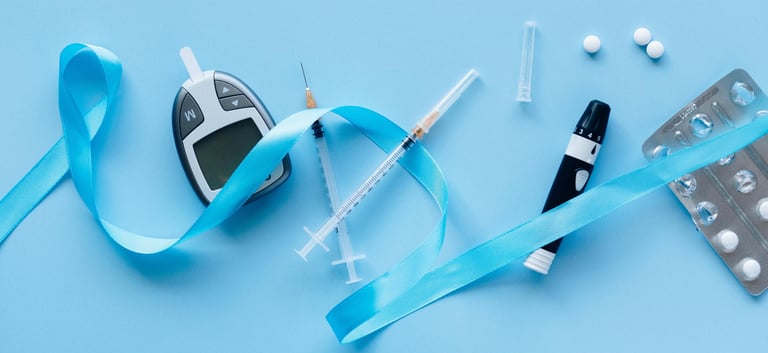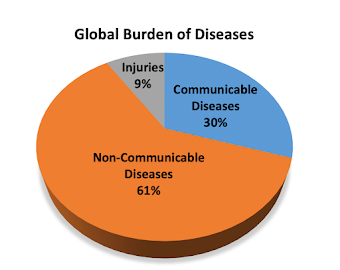Emerging Health Trends: A Post Pandemic Perspective
From leveraging AI in diagnostics to reshaping personal health practices, we examine the health trends defining our post-pandemic world. Explore the latest health trends reshaping wellness and healthcare in the wake of COVID-19 pandemic
Written by Juergen George, BSc Biotechnology
5/8/20243 min read
The COVID-19 pandemic exposed critical gaps in global healthcare systems, spurring advancements in medicine, technology, and public health
Noncommunicable Diseases: A Growing Challenge
Noncommunicable diseases (NCDs) like obesity, cardiovascular disease, and diabetes account for nearly three out of every four deaths globally. Key contributors include:
· Tobacco use, leading to chronic respiratory conditions.
· Unhealthy diets, resulting in obesity and heart disease.
· Air pollution, exacerbating respiratory and cardiovascular conditions.
· Genetics, predisposing individuals to conditions like diabetes or cancer.
A study by the NCD Alliance reports that 17 million people under 70 die annually from NCDs, with 86% of these deaths occurring in low- and middle-income countries.
Communicable Diseases: Persistent Global Threats
Despite significant progress, communicable diseases remain a major health concern.
Key diseases include:
· HIV/AIDS
· Influenza
· Malaria
· Sexually transmitted diseases (STDs)
· Tuberculosis
Efforts to Combat Communicable Diseases
· Vaccination programs: Covering nearly 90% of children globally as of 2018.
· Antiretroviral therapy: Saving 13.6 million lives to date.
· Early warning systems: Utilizing technology to detect disease outbreaks.
Substance Abuse: An Escalating Crisis
Substance abuse, including misuse of prescription drugs, is a serious global issue.
Notable Examples
· Fentanyl, an opioid 50–100 times more potent than morphine, has contributed to a sharp rise in overdose deaths.
· Ozempic, designed for type 2 diabetes, is now controversially used as a weight-management drug.
The Kaiser Family Foundation highlights that opioid-related deaths outnumber those caused by cocaine by a factor of three. While teenage overdose deaths have risen, alcohol consumption among teens has seen a decline.
Diet Culture: Evolving Perspectives
Diet trends and eating behaviors continue to shape health outcomes.
Emerging Patterns
· Fasting: Intermittent fasting and extreme regimens like OMAD (One Meal a Day) are gaining popularity.
· Eating disorders: Conditions like anorexia reflect the darker side of diet culture.
· Different types of diet: Diet types have also increased with each gaining and influencing dietary choice
· Supplementation: Veganism and nutrient-deficient diets have increased reliance on supplements, particularly for B12.
· New knowledge: The availability of more knowledge through documentaries like: ‘What the Health’ and ‘Live to 100: secrets of the Blue Zones’ have also caused a shift on peoples’ choices of food.
Personalized Medicine: The Future of Healthcare
Advances in biotechnology and genomics are paving the way for precision medicine.
· Tailored treatments improve efficacy and reduce side effects.
· Antibiotic resistance may be mitigated through genetic insights.
Biohacking: Redefining Personal Health
Biohacking involves small, intentional changes to optimize physical, mental, and dietary health.
It uses some aspects of functional medicine
Popular Biohacks
· Nootropics to enhance cognitive function.
· Cold plunging and saunas.
· Blood testing to identify nutritional needs.
· Wearable devices for health tracking (e.g., sleep monitors).
· Red light Therapy
· Waiting for 90 minutes before coffee after waking up
· Intermittent or longer fasting
· Meditation
· Sunlight exposure first thing after waking up
Caution: Some aggressive biohacks, like attempting to alter vision or perform self-surgeries, can be harmful.
An example is the “ 2015 Gizmodo piece ” when a man tried to give himself night vision abilities.
Exercise and Supplementation: Addressing Sedentary Lifestyles
Modern automation has reduced physical activity, prompting more people to join gyms, running clubs, and fitness communities. Meanwhile, declining nutrient content in foods has led to increased reliance on supplements to meet dietary needs.
It should be noted that the use of supplementation itself is a form of biohacking.
Population Dynamics: Impacts on Healthcare
The global population is expected to peak in the 2080s at 10.3 billion before slightly declining. Factors influencing this trend include:
· Fertility rates: Dropped from 3.31 live births per woman in 1990 to 2.25 today.
· Lifespan: Increased from 64.6 years (1990) to 72.6 years (2019).
· Urbanization: Over half the global population now lives in urban areas.
Key Takeaways
The future of healthcare lies in AI, wearable technology, and precision medicine.
Communicable diseases, exacerbated by globalization, remain as the greatest pressing concern.
Noncommunicable diseases are a significant global challenge.
Opioid abuse continues to claim the most lives among drug-related deaths.
Biohacking offers innovative ways to optimize health but should be approached with caution.
You May Also Like
Processed and Ultra-processed foods: What you need to know
Vitamin D: How important is it?
Disclaimer:
This content is for informational purposes only and should not replace professional medical advice.



